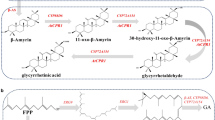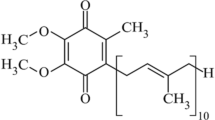Abstract
The tropical plants Garcinia cambogia and Hibiscus subdariffa produce hydroxycitric acid (HCA), of which the absolute configurations are (2S,3S) and (2S,3R), respectively. (2S,3S)-HCA is an inhibitor of ATP-citrate lyase, which is involved in fatty acid synthesis. (2S,3R)-HCA inhibits pancreatic α-amylase and intestinal α-glucosidase, leading to a reduction in carbohydrate metabolism. In this study, we review current knowledge on the structure, biological occurrence, and physiological properties of HCA. The availability of HCA is limited by the restricted habitat of its source plants and the difficulty of stereoselective organic synthesis. Hence, in our recent study, thousands of microbial strains were screened and finally two bacterial strains were, for the first time, found to produce trace amounts of HCA. The HCA variants produced were the Hibiscus-type (2S,3R) enantiomer. Subsequent genome shuffling rapidly generated a mutant population with improved HCA yield relative to the parent strain of bacteria. These bacteria are a potential alternative source of natural HCA.


Similar content being viewed by others
References
Bischoff H (1994) Pharmacology of α-glucosidase inhibition. Eur J Clin Invest 24:3–10
Boll PM, Sorensen E, Balieu E (1969) Naturally occurring lactones and lactames. III. The absolute configuration of the hydroxycitric acid lactones: Hibiscus acid and garcinia acid. Acta Chem Scand 23:286–293
Brämer CO, Steinbüchel A (2001) The methylcitric acid pathway in Ralstonia eutropha: new genes identified involved in propionate metabolism. Microbiology 147:2203–2214
Brock M, Darley D, Textor S, Buckel W (2001) 2-Methylisocitrate lyases from the bacterium Escherichia coli and the filamentous fungus Aspergillus nidulans. Eur J Biochem 268:3577–3586
Cheema-Dhadli S, Halperin ML, Leznoff CC (1973) Inhibition of enzymes which interact with citrate by (−)-hydroxycitrate and 1,2,3-tricarboxybenzene. Eur J Biochem 38:98–102
Coppola GM, Schuster HF (1997) Chiral α-hydroxyacids in enantioselective synthesis. Wiley-VCH, Weinheim, Germany
Ewering C, Heuser F, Benölken J, Brämer C, Steinbüchel A (2006) Metabolic engineering of strains of Ralstonia eutropha and Pseudomonas putida for biotechnological production of 2-methylcitric acid. Metab Eng 8:587–602
Gerike U, Hough DW, Russell NJ, Dyall-Smith ML, Danson MJ (1998) Citrate synthase and 2-methylcitrate synthase: structural, functional and evolutionary relationships. Microbiology 144:929–935
Ghosh AK, Koltun ES, Bilcer G (2001) Tartaric acid and tartarates in the synthesis of bioactive molecules. Synthesis 9:1281–1301
Guthrie RW, Hamilton JG, Kierstead RW, Miller ON, Sullivan AC (1976) U. S. Patent 3966772
Griebel C (1939) Hibiscus “flowers”, a drug used in the preparation of food and drink, its principal component a new acid of fruit acid character (hibiscus acid). Zeit Untersuch Lebensmitt 77:561–571
Griebel C (1942) The constitution and detection of hibiscus acid ((+)-allohydroxycitric acid lactone). Zeit Untersuch Lebensmitt 83:481–486
Hansawasdi C, Kawabata J, Kasai T (2000) α-amylase inhibitors from roselle (Hibiscus sabdariffa Linn.) tea. Biosci Biotechnol Biochem 64:1041–1043
Hansawasdi C, Kawabata J, Kasai T (2001) Hibiscus acid as an inhibitor of starch digestion in the Caco-2 cell model system. Biosci Biotechnol Biochem 65:2087–2089
Hida H, Yamada T, Yamada Y (2005) Production of hydroxycitric acid by microorganisms. Biosci Biotechnol Biochem 69:1555–1561
Hida H, Yamada T, Yamada Y (2006) Absolute configuration of hydroxycitric acid in microorganisms. Biosci Biotechnol Biochem 70:1972–1974
Hida H, Yamada T, Yamada Y (2007) Genome shuffling of Streptomyces sp. U121 for improved production of hydroxycitric acid. Appl Microbiol Biotechnol 73:1387–1393
Hoffman GE, Andres H, Weiss L, Kreisel C, Sander R (1980) Properties and organ distribution of ATP citrate (pro-3S)-lyase. Biochim Biophys Acta 620:151–158
Ibnusaud I, Thomas PT, Rani RN, Sasi PV, Beena T, Hisham A (2002) Chiral γ-butyrolactones related to optically active 2-hydroxycitric acids. Tetrahedron 58:4887–4892
Jena BS, Jayaprakasha GK, Singh RP, Sakariah KK (2002) Chemistry and biochemistry of (−)-hydroxycitric acid from Garcinia. J Agric Food Chem 50:10–22
Jenkins DJ, Taylor RH, Goff DV, Fielden H, Misiewicz JJ, Sarson DL, Bloom SR, Alberti KG (1981) Scope and specificity of acarbose in slowing carbohydrate absorption in man. Diabetes 30:951–954
Kasai T, Kawabata J, Hanswasdi C (2000) Japan Kokai Tokkyo Koho 239164
Karaffa L, Kubicek CP (2003) Aspergillus niger citric acid accumulation: do we understand this well working black box? Appl Microbiol Biotechnol 61:189–196
Kotera U, Umehara K, Kodama T, Yamada K (1972) Isolation method of highly tartaric acid producing mutants of Gluconobacter suboxydans. Agric Biol Chem 36:1307–1313
Lewis YS, Neelakantan S (1965) (−)-Hydroxycitric acid—the principal acid in the fruits of Garcinia cambogia Desr. Phytochemistry 4:619–625
Lewis YS (1969) Isolation and properties of hydroxycitric acid. Methods Enzymol 13:613–619
Loe YC, Bergeron N, Rodriguez N, Schwarz JM (2001) Gas chromatography/mass spectrometry method to quantify blood hydroxycitrate concentration. Anal Biochem 292:148–154
Lowenstein JM (1971) Effect of (−)-hydroxycitrate on fatty acid synthesis by rat liver in vivo. J Biol Chem 246:629–632
Lowenstein JM, Brunengraber H (1981) Hydroxycitrate. Methods Enzymol 72:486–497
Mattey M (1992) The production of organic acids. Crit Rev Biotechnol 12:87–132
Milsom PE (1987) Organic acids by fermentation, especially citric acid. Food Biotechnol (Lond) 1:273–307
Patnaik R, Louie S, Gavrilovic V, Perry K, Stemmer WPC, Ryan CM, del Cardayré SB (2002) Genome shuffling of Lactobacillus for improved acid tolerance. Nat Biotechnol 20:707–712
Rao RN, Sakariah KK (1988) Lipid-lowering and antiobesity effect of (−)-hydroxycitric acid. Nutr Res 8:209–212
Sullivan AC, Triscari J, Hamilton JC, Miller ON (1974) Effects of (−)-hydroxycitrate upon the accumulation of lipid in rat. II. Appetite. Lipids 9:129–134
Sullivan AC, Singh M, Srere PA, Glusker JP (1977) Reactivity and inhibitor potential of hydroxycitrate isomers with citrate synthase, citrate lyase, and ATP citrate lyase. J Biol Chem 252:7583–7590
Tabuchi T, Serizawa N (1975) The production of 2-methylcitric acid from odd-carbon n-alkanes by a mutant of Candida lipolytica. Agric Biol Chem 39:1049–1054
Tattersall R (1993) α-glucosidase inhibition as an adjunct to the treatment of type 1 diabetes. Diabet Med 10:688–693
Tsao GT, Cao NJ, Du J, Gong CS (1999) Production of multifunctional organic acids from renewable resources. Adv Biochem Eng Biotechnol 65:243–280
Watson JA, Fang M, Lowenstein JM (1969) Tricarballylate and hydroxycitrate: substrate and inhibitor of ATP: citrate oxaloacetate lyase. Arch Biochem Biophys 135:209–217
Zhang YX, Perry K, Vinci VA, Powell K, Stemmer WPC, del Cardayré SB (2002) Genome shuffling leads to rapid phenotypic improvement in bacteria. Nature 415:644–646
Acknowledgements
The authors are cooperating within the “High-Tech Research Center” Project for Private Universities on Evolution of Green Science for Quality Improvement of Environmental and Health: matching fund subsidy from Ministry of Education, Culture, Sports, Science and Technology (MEXT), 2004–2008.
Author information
Authors and Affiliations
Corresponding author
Rights and permissions
About this article
Cite this article
Yamada, T., Hida, H. & Yamada, Y. Chemistry, physiological properties, and microbial production of hydroxycitric acid. Appl Microbiol Biotechnol 75, 977–982 (2007). https://doi.org/10.1007/s00253-007-0962-4
Received:
Revised:
Accepted:
Published:
Issue Date:
DOI: https://doi.org/10.1007/s00253-007-0962-4




